#bed of lettuce I grew on my balcony
Text
eating a hunter gatherer meal (putting craisins in my sausage wrap)
#full recipe IS:#tortilla spread with Vermont Herb Spreadable Farmer's Cheese that looked good at the farmstand#bed of lettuce I grew on my balcony#grilled red wine and garlic sausages that looked good at the farmstand#chickpeas Audrey roasted for something else earlier#and a scattering of craisins and pistachios#we will see how this goes. his trail mix swag#.txt
11 notes
·
View notes
Text
Thess vs Herb Garden Day 76 - Words-Only Update
On to happier subjects. Briefly, because the weekend has arrived and I am goingto find enough spoons to do something fun before bed. But first: what’s going on in my life that doesn’t involve the political and economic situation in this country because Tumblr keeps throwing posts from an account called ayeforscotland and ... I mean, I guess? But I honestly come here to vent about the situation and then scroll through stuff that isn’t about the current political and economic situation in this country so I find this “Based on” shit really intrusive.
ANYWAY. PLANT NEWS.
I had to do an emergency repot of my parsley and chives, because they had well and truly outgrown their pots. I also had to be realistic about exactly how much parsley and chives I actually needed to have growing, so now I have a reasonable amount of both. Also some space in the new multi-planter for the upcoming marjoram. Or maybe the thyme. Or the oregano. Or the rosemary.
On to the rest of the herbs: my coriander/cilantro is flowering. I’m just leaving it be for the seeds later. My dill is getting HUGE. My mint is quietly thriving. This weekend, I am going to make bolognaise with fresh basil because my basil is also doing well - not quite enough yet for pesto but give it time. As for my lemon balm ... well, it’s definitely doing pretty well, so long as I keep the lettuce contained.
Yeah, the lettuce. The lettuce is ... a lot. I do manage to keep that down by the simple expedient of having salad. All the salad. I have grown some very tasty lettuce, I have to say.
The spinach, on the other hand ... the spinach has pretty well bolted by this point. And no one told me that spinach bolting gives off so much pollen that it’s a hayfever sufferer’s nightmare. I’ll plant more and earlier next year; it’s too hot to get much out of spinach before it bolts now.
On the subject of flowering, the spinach and the coriander/cilantro is not the only thing that’s flowering. The spring onions left over from that long-ago pasta bake I cooked? The ones I rooted, planted and grew? They’re also flowering. Which I think is really neat, personally.
My tomato plants are doing great, though some of them were kind of flopping over. I seemed to remember that fastening the tomato plants to stakes was a thing ... and then I remembered all the chopsticks I used to get from Chinese takeaways. I never used them, because I have my own good chopsticks and would not put that splintery crap into my mouth if it could be avoided - but I never threw them away, either. So I used those as beginner stakes, tying my young tomato plants to them with twist-ties. There’ll be pictures later; it worked great.
My pea plants are getting big enough to be vaguely scary. So are my potato plants.
I’ve been pricing pots and planters that can be hung from a balcony rail - the kind of thing that won’t be super-attractive to pigeons but will give me more space for my plant babies. Next week - planters and MORE DIRT. (Still can’t believe I have to buy dirt.) My peppers and various other herbs need new homes, and while my onions, carrot, and beetroot also need new homes, those are for the grow-bags, since there’s more space for root veggies there. Wish I could find a good sort of staged platform to put the grow-bags on to take advantage of the little bit of light the balcony gets, but I’ll ponder it. If I can Macguyver up some stakes for baby tomato plants out of chopsticks, I’m sure I’ll think of something.
4 notes
·
View notes
Note
What do you do for hobbies, apart from gardening? What have you been growing in the garden? Do you have any favourite plants?
Hobbies?
It's a little strange to think of things as hobbies - given the life I've led, but I suppose they are, huh?
Motorcycles - I like riding, but I enjoy a bit of grease-monkeying too. I like to work on them. I have a project I'm working on now - something I found at an auction that needs some repair work. Not sure what I'll do with it when I get it finished, but it gives me something to do.
Reading - I have a lot to catch up on. Sometimes it's news articles on microphish, but when I feel like just enjoying a read - not going to lie, sci fi and high fantasy are my bag.
Building - I have an A-frame cottage I've been working on in upstate New York. Finished the majority of it last year. It's a nice, private little spot I can go to get away from ... everything. Nobody and nothing but hills, trees and meadows for miles in any direction. Literal miles. I put a lot of myself into that place - and I know every nook and cranny in intimate detail. I like smaller projects too - all the trellises and planter boxes on the roof - I did those with a little help from the neighbors.
And Gardening, obviously. It was a way to channel all my .. energy.. into something productive. To prove to myself I could keep things alive. That I could care for something. I heard plants were a good first step, so I rescued some wilty little Pothos from a broken planter in the trash. I was able to bring it back - it was one of the first residents of the rooftop garden, but before that it lived in the kitchen and out on the balcony in nice weather. It's my favorite, probably for predictable reasons.
The garden is sort of a community project. It started with just a few planters for growing some food things from grocery waste - avacado seeds and celery cut offs, that sort of thing. But the neighbors liked it and so it grew. Next thing I know, we're building a little green house up there together. We got a little seating area. We have more planters and more people are contributing. We have trellis and string lights..
I didn't plan for it but I'm glad it's going this way. It's providing income for some of the families who wouldn't otherwise have any ... they can take the stuff that we grow up there and sell it at the farmer's markets. They can trade with people in the are for other things.
We're still working out what grows and what doesn't and how to care for everything, but we have a huge variety of stuff up there. Potted herbs - the kind you'd expect. Rosemary, Mint, Thyme, Chives and so on. We have a few rows of leafy greens.. like cabbage, lettuces, kale, celery. We have a row of hanging tomato plants. We have a few deep beds or things carrots and potatoes. And I've made sure to scatter some pollinator positive things out there, too. Butterfly bushes and things bees and butterflies like.
We have some berry bushes, a strawberry patch everyone is looking forward to this year. Last July we had a really nice fireworks viewing party up there and we're going to do the same for the New Year. A little music, the lights on, barbeque stuff (yes even in the cold).
We have plans to expand - One of the ladies knows how to grow a variety of melons from a hanging sort of trellis set up? So we're going to try that and the kids are always bringing me stuff they want to try and grow. I think we're going to try some beans this year, too.
And we just finished a chicken coop and run.. I'm looking forward to bringing some chooks home when the weather warms up.
3 notes
·
View notes
Text
Summer Gardening.
So it’s been a while, and for that I apologize to the... 200+ people who follow me. I’m sure y’all are here for the cat pics and the nekked men, but TOO BAD. Today you get to suffer through pics of my green children.
Also, I do share seed. My seed list link will be up later in the year.
To begin with, the summer flowers are out en force:
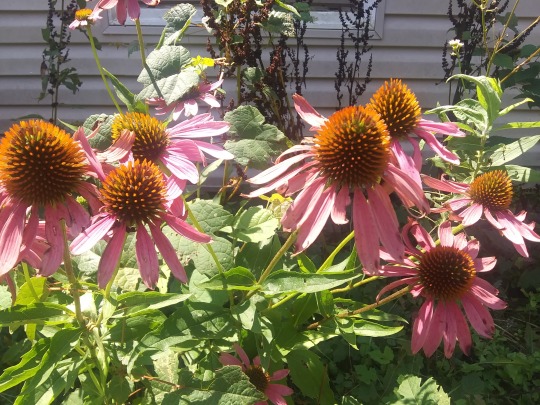
Echinacea Purpurea, the original echinacea. I do save yearly seed from these guys, although it’s an incredibly pointy, stabby and bleed-y job.
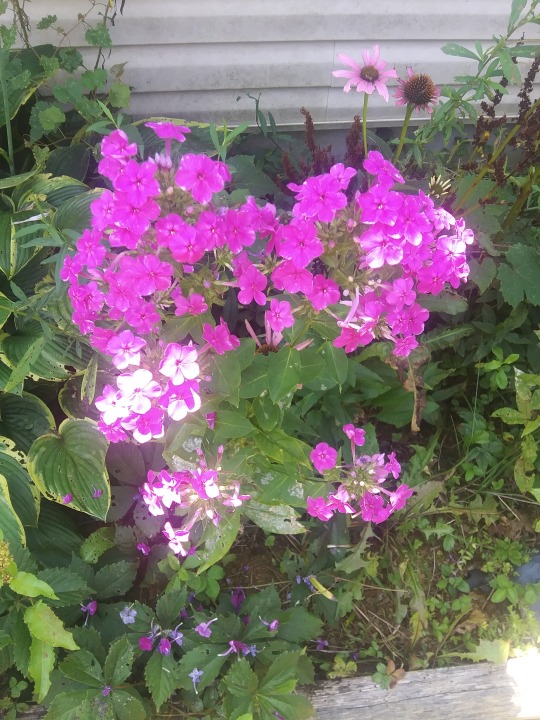
Mountain Phlox. Unfortunately, all of it around the house is afflicted with powdery mildew, so I will not share seed. But it’s still pretty to look at, and the clearwings (hummingbird moths) love it. Not pictured is the white variant, who grows on the other side of the house. Look, it was hot and I was already melting.
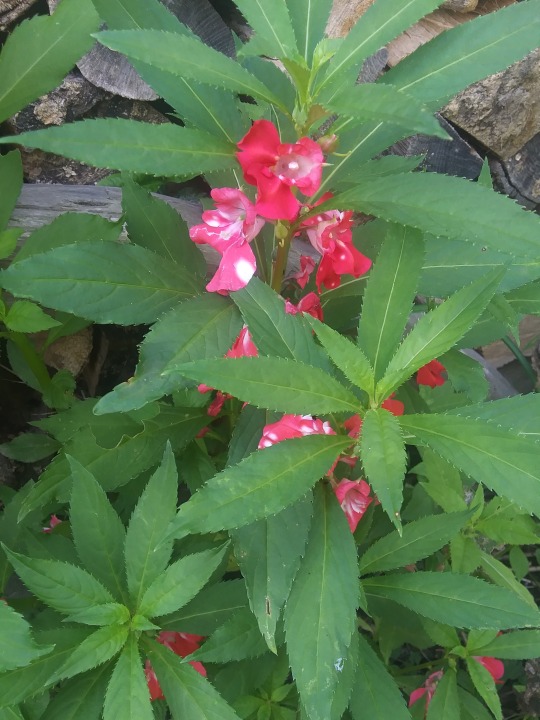
Peppermint Balsam. This thing is basically indestructible, for an annual. It will reseed freely (to truly Lovecraftian levels) and blooms continuously from late spring until mid-fall, when the seed-pods set. There is a dormant genetic in it for double flowers, but when it pops up it’s always been sterile. It just pops up occasionally from the peppermint seed.

I may give the roommate hell over the hostas (I hate them. They’re so useful to protect toads and control weeds, but I hate them), but they do put out pretty flowers. There are several variants around the house - white-edged, blue and green, but hostas in general are very, very hard to start from seed. I will save it on request, only.
We were also incredibly lucky to have a Moth Mullein sprout in our porch bed, along with some Variegated Solomon’s Seal.The SS doesn’t put out seeds, and I don’t have enough to share bulbs (yet), but the mullein has been exceptionally generous with seed pods, and it repels bugs. It repels ROACHES. It’s going everywhere. And I may be convinced to part with some seed.
Onward!
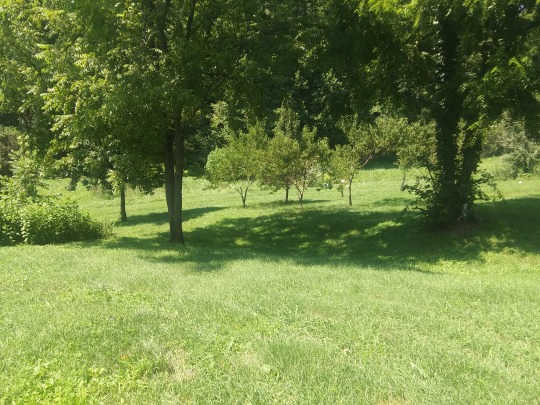
A view from a hill. Can you see the garden? That’s OK, I can’t either. Those are peach trees, on the side of the orchard closest to the house. Unfortunately a freak storm during early spring killed all the blossoms. Also, don’t mistake ‘orchard’ for ‘organized’. There’s a pear, some apples, a plum, some nectarines? And front and center are two walnuts. I’ll probably be plunking my laurel there to see if it survives winter. And someday when I have a job and money again, I would like to drop a few Chicago Hardy figs, and maybe a kiwi trellis.
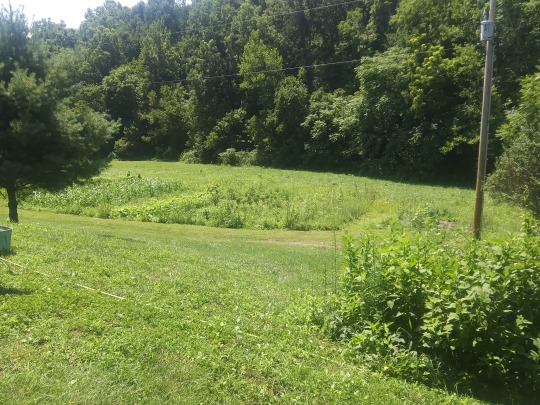
This is the big garden (and fortunately not my responsibility, or I would cry). The guys are ‘handling’ it. The weeds say otherwise.
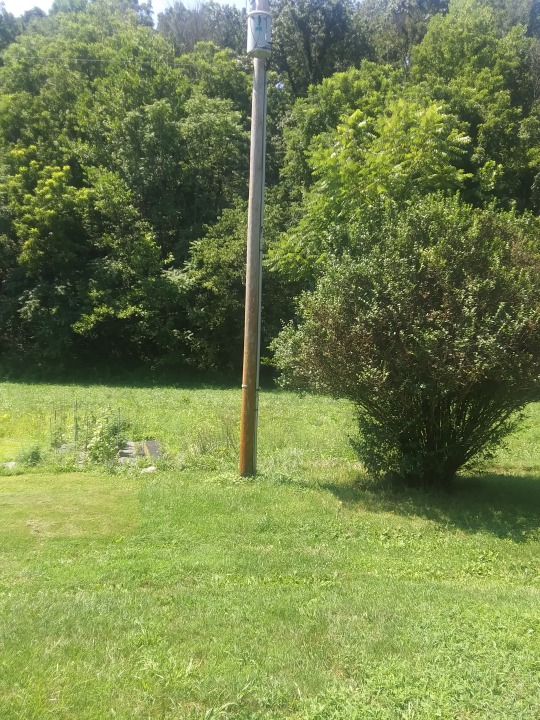
The jasmine tree and the roommate’s garden. Because of a bad back injury that refuses to heal, I’ve been helping them on and off with it. And if you thought jasmine was supposed to stay a delightful little bush, AHAHAHAHAH. Yes, that’s a light-post next to it. For size comparison.
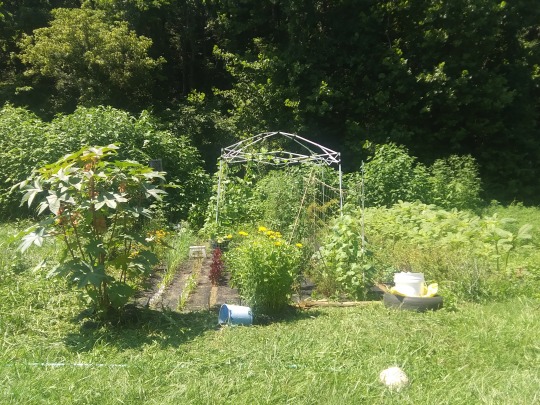
MY CHILDREN. Please ignore the dead soccer ball. That’d be a dog toy.

Lemon balm, amaranth, and a new bed that I’ll be finishing off during fall, for use next year. The lemon balm is a permanent row - it will overwinter just fine, and it will even keep growing through the mildest part of December. Mine didn’t die back until a few solid days of sleet in January. Unfortunately the weed fabric under the amaranth turned out to be an old roll, and fell apart on me (no big, the whole point is for it to fall apart eventually), so the weeds have kinda eaten it alive.

Unfortunately, both cucumber beetles and blister beetles love the amaranth. Fortunately, it does not seem to give a damn. It’s an incredibly resilient plant, not minding weeds, bugs, flood or drought. We’ll see what the grain actually tastes like, but so far it’s looking like a good candidate for continuous growing.

The lemon balm is lemon-balming. Planted on a lark, it’s proven to be a fantastic wind-breaker - because it grows so early and so quick, it keeps the colder winds that come down through the hollow from my more fragile seedlings, like the lettuce, dill and cilantro. You can see here where the spent flower-heads are dying but there’s new growth underneath; I really have to get in there and behead it. It makes nice hot tea, meh cold tea, and hanging fresh bunches of it around the balcony keeps the skeeters off. It also seems to be a decoy for cabbage moths.
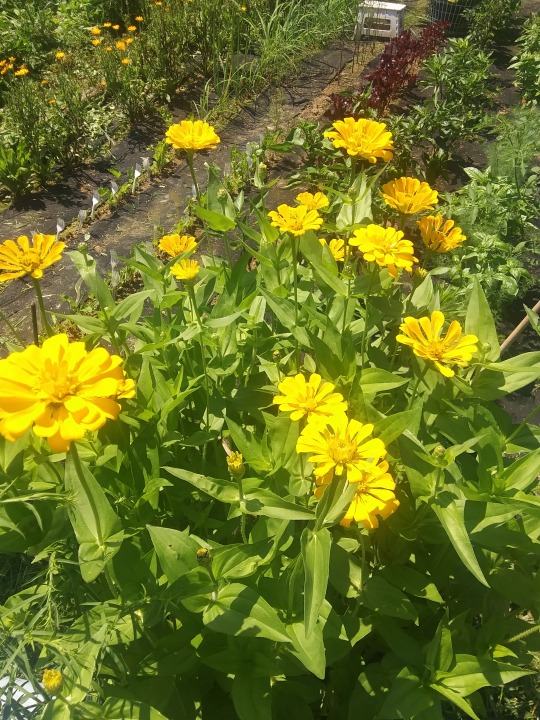
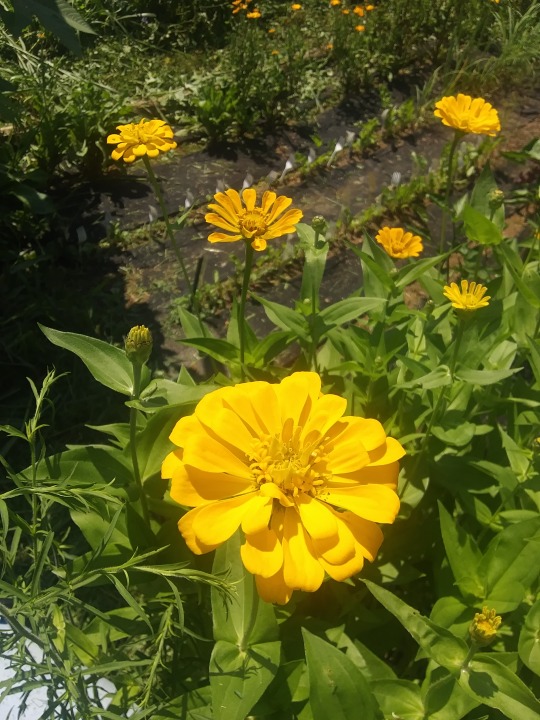
Canary Zinnia. The seed was sent to me as a gift with one of my seed orders, and this is my first year growing it. -If- I can save some, I’ll definitely be sharing and growing again. It’s a lovely plant, very sturdy, and the bees love it.

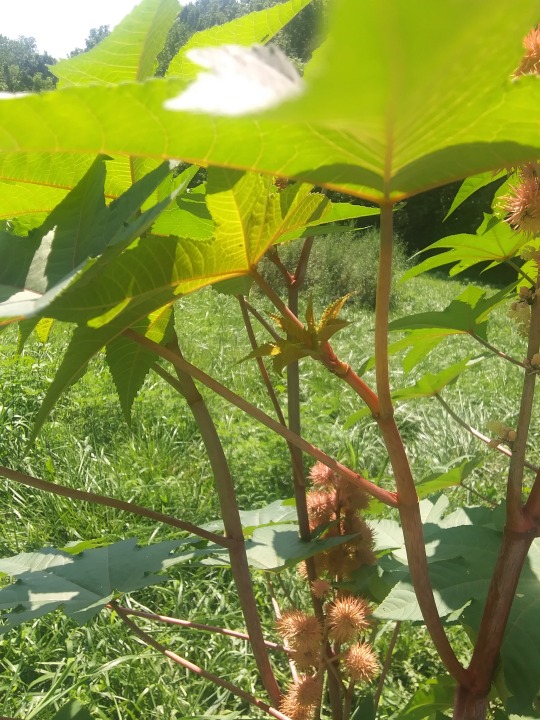
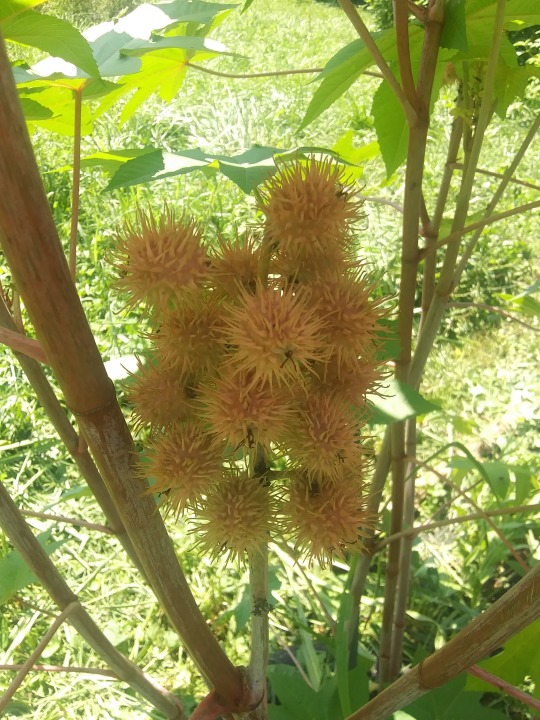
Dwarf Castor Oil. I don’t think there’s anything dwarf about it, but then I’m a short green witch myself, so maybe it’s all about perspective. Don’t let the pods lie to you, until they dry the spikes are relatively soft. However, it being castor oil, I don’t recommend it to anyone with ducks, chickens, goats, or anything that might accidentally try talking a nibble or pecking at the beans. I do, however, recommend them from jewelry if you know how to pierce things and so on. They are a gorgeous tiger-stripe pattern.
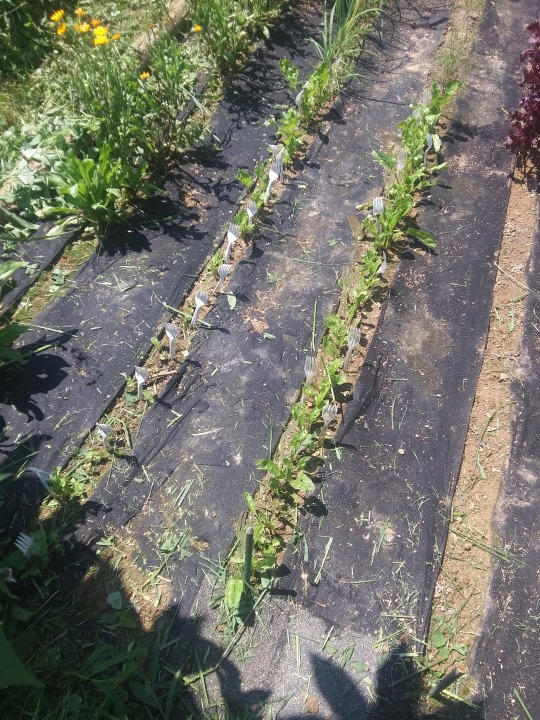
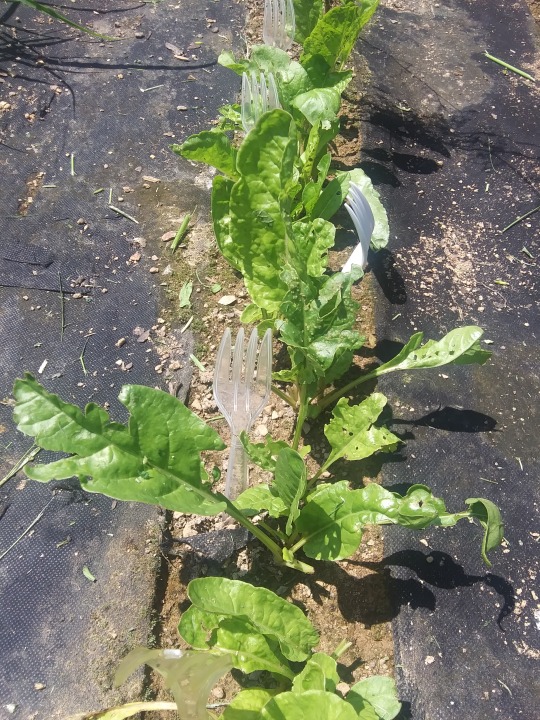
Say hello to the chard! Say goodbye to the chard! Nothing else, absolutely nothing else since the limas, has given me so much trouble. The deer love getting into my chard bed and destroying it (ergo all the forks). And once I managed to chase those off, the blister beetles showed up in force. This will be the last year I grow it - we just don’t eat enough of it to make it worth my while, and it only occasionally sold at the Farmers’ Market.
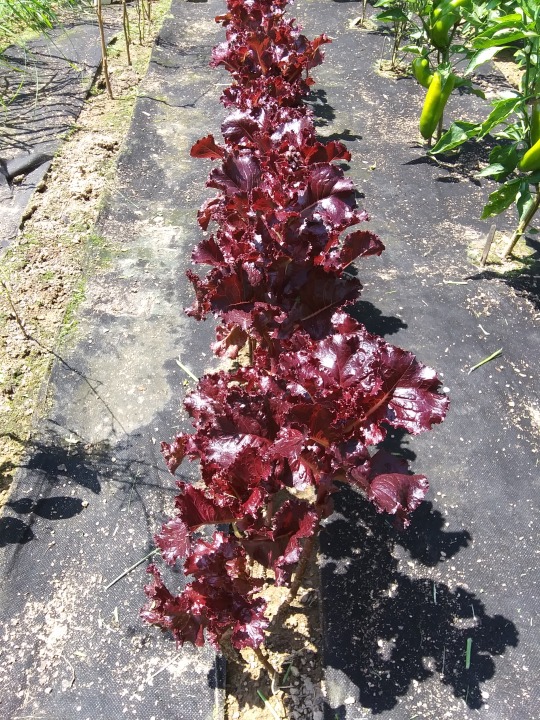
Red lettuce - Merlot and Lollo Vino, a combination of bought and saved seed. I planted a red romaine of some sort, too, but unsurprisingly it bolted in the heat. The darker reds of my favorites, though, keep bugs off them, keep deer from noticing them, and keep them from bolting. It’s just now threatening to, and at this point its kind of allowed. I need more seed for next year. Seed for this will likely be shared by the teaspoon-ful.
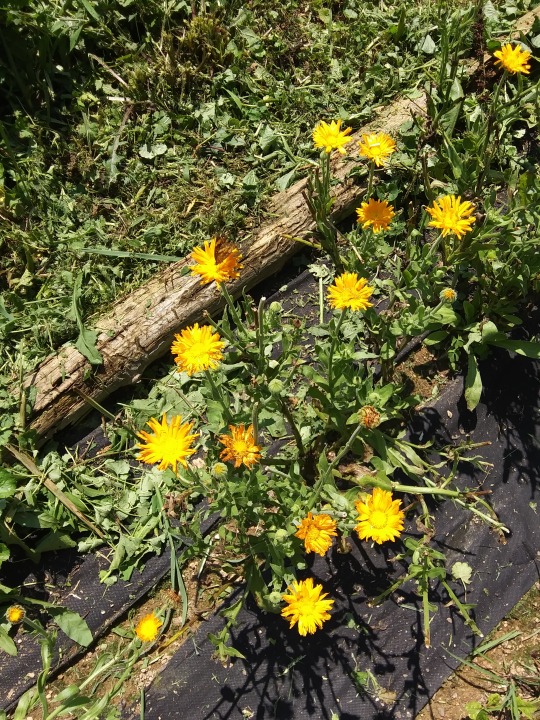
Calendula! I searched for a long time to find the plain ol’ calendula officinalis ancestor, rather than a cultivar where I would have no way of knowing if the medicinal principles would have been sacrificed for looks. It’s supposed to work well as poor man’s saffron (color, no taste), and I’m going to be soaking the heck outta my feet on it during winter. The plant is... not pretty. It gets leggy and the leaves get grotty very quickly. But it’s very sturdy and as long as you cut the flowerheads off as fast as you can, it’ll keep blooming until well into winter. I usually leave it to go to seed around late September.
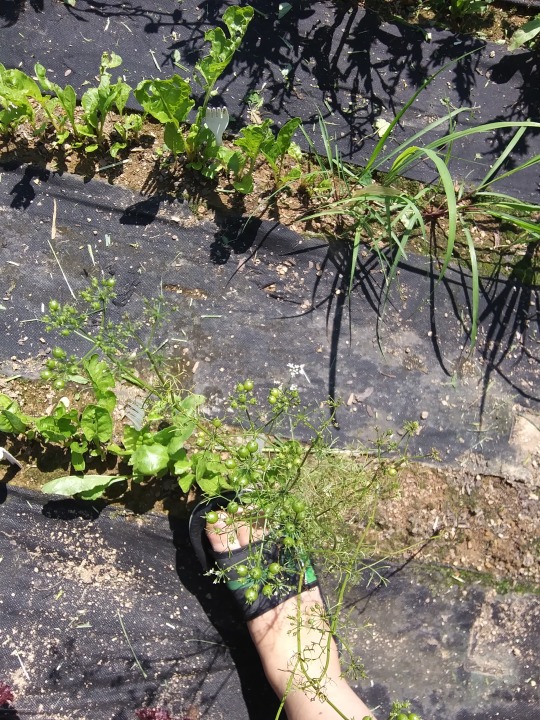
Green cilantro seeds. You pick ‘em when they’re brown, but before they drop off the plant. Or you pick ‘em when they’re brown-ing, and put them in a paper bag so they’ll finish ripening there and you don’t end up with fifty wild cilantro plants in your garden >_> Most of the row is already gone, and I’ll be putting in a late dill crop in its place. No such thing as too much dill!
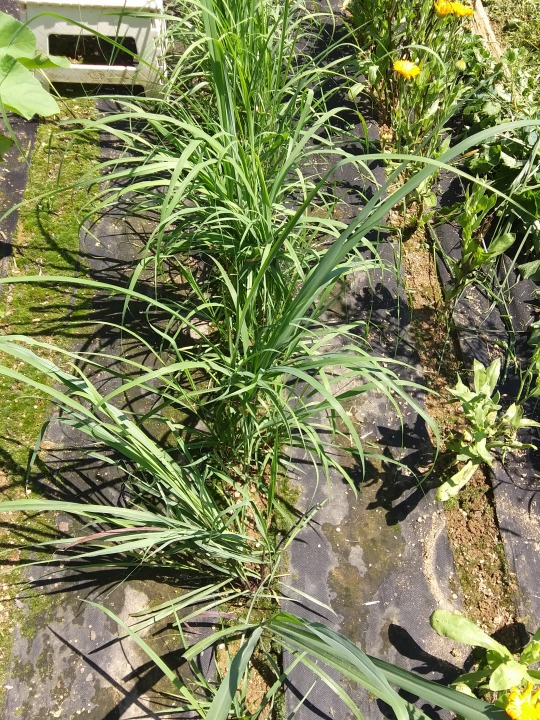
Don’t let lemongrass lie to you. Unless you tie it up, it will not grow up neat and tidy, as most grass does. Instead it will sprawl like a dramatic wilting Elizabethan lady and do its best to end up under your feet so you’ll feel bad about it. I just tie it up with a half-blade of grass; it dries up and withers away before it can hurt the plant.
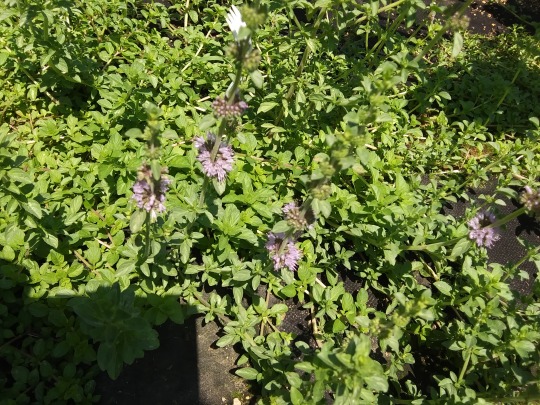
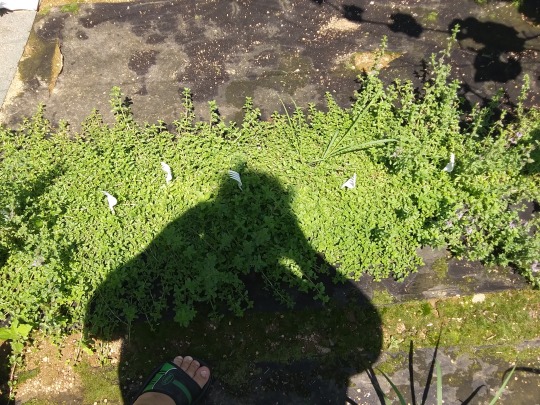
I ordered pennyroyal seed because... Well, because it’s something one should have on hand, considering the way the world is going. What I got was Creeping Pennyroyal, which doesn’t care if you step on it (mint family), smells absolutely delightful, and has the most adorable, tiny purple flowers. I plan on harvesting, drying and sprinkling it everywhere in the crawlspace under the house. Making war on cave crickets, wood roaches, and other such sundries, me.

The thyme and Spicy Oregano took a beating in the heat, but they’re slowly bouncing back. The bed behind them is more pennyroyal, desperately in need of weeding, but there’s only one of me, y’know.

SIGH.
Just.
You absolute, ill-mannered monster of a creature.
That would be horseradish, gloriously happy to be alive, as horseradish should be. Also, NOT IN ITS BASKET. Because never mind the rules, I guess.

I don’t even know how I’m gonna dig that up come winter. With some construction equipment, I GUESS.

Decorative gourd! It’s the only one producing so far, but being the seed was 10+ years old, I’m very pleased.

And an apple gourd (I think?), from a mixture of drying gourds that was only slightly less ancient. Snake, apple and birdhouse gourds. There’s a bunch of them competing in the basket at this point, we’ll see what we will see.
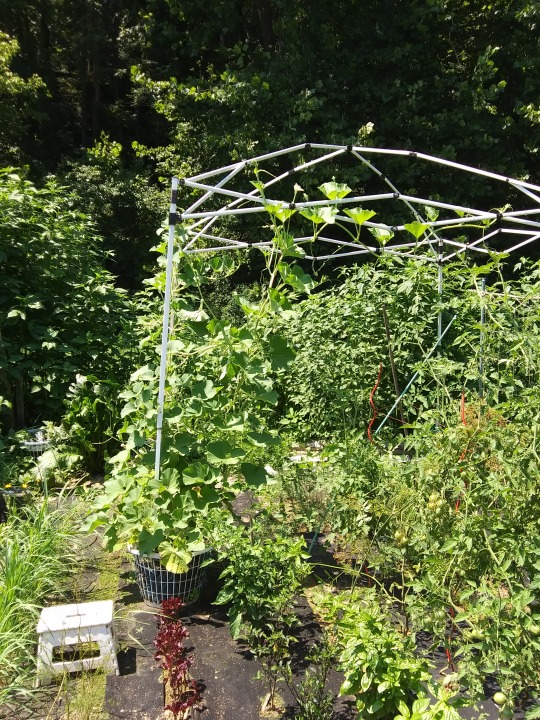
And this, I think, is a great use of a dead canopy frame (the dogs ate the canopy. No, I’m not making it up.) I hope to coax the gourds to grow me a lil’ roof so I can sit in shade, surrounded by pennyroyal anti-skeeter barriers, eating my maters.
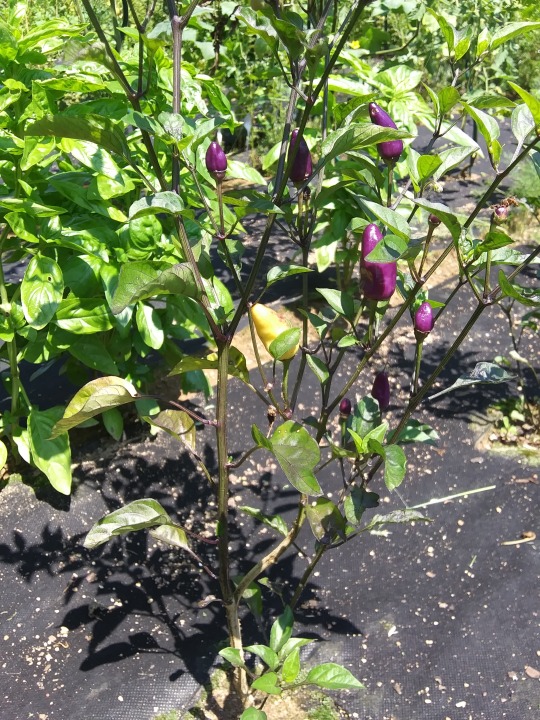
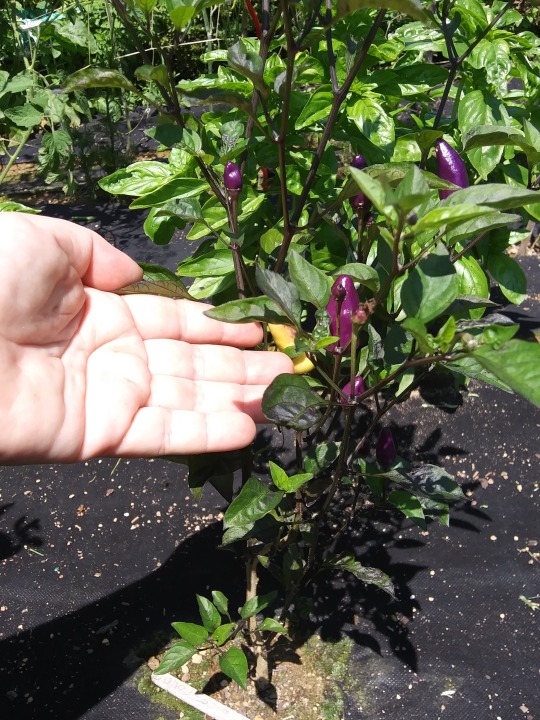
My Peter Peppers (nrehehehehe) aren’t producing yet - it takes them a while. But my Chinese 5-Color are getting started. It’s a lovely pepper, both edible and ornamental, with (so I’m told) about four times the heat of a Jalapeno. They’re tiny, with deep purple undertones to the plant. They’ll go purple-white-yellow-orange-red.


The bullhorns, on the other hand, are fairly sizable SWEET peppers on very tiny plants, and I honestly suggest staking them while they’re young so they grow a sturdy trunk, else you might end up with all of them growing at a slant.They’re just now beginning to turn colors. Keeping in mind I’m virulently allergic to peppers (less so sweet than hot, but allergic to all of them), the roommate loves ‘em.
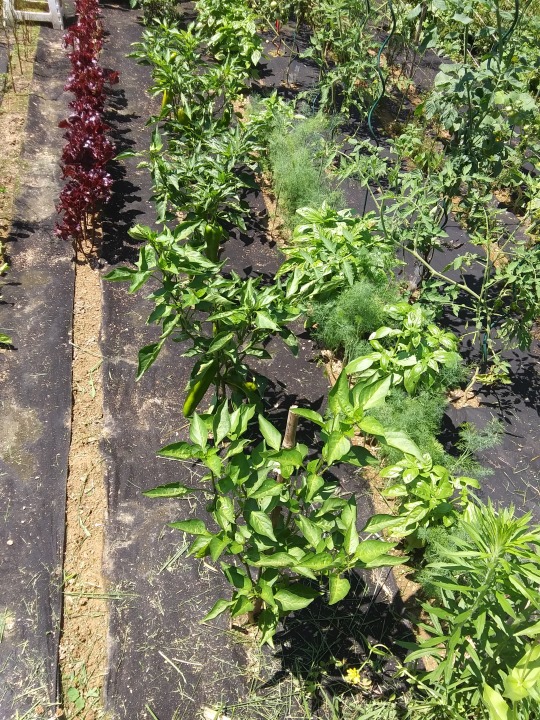
It’s a small pepper bed - mainly to refresh my seed on the hots, and to grow sweets for the roommate. Pardon the nekked bed, the autumn lettuce hasn’t sprouted yet. And yes, that’s a mixed basil/dill bed next to it. My basil grew in patchy holes (NEVER buying from those seed people again), so I filled the holes with dill. Unfortunately, dill seed heads are so fine that they’re hard to photograph well.

The tomato row. After arguing with them for this long, I went the extra mile. Every plant has a metal stake. There’s also a double line growing at the top supporting the stakes so they don’t fall over. And they still fell over. Because why not, you unruly children, why not.


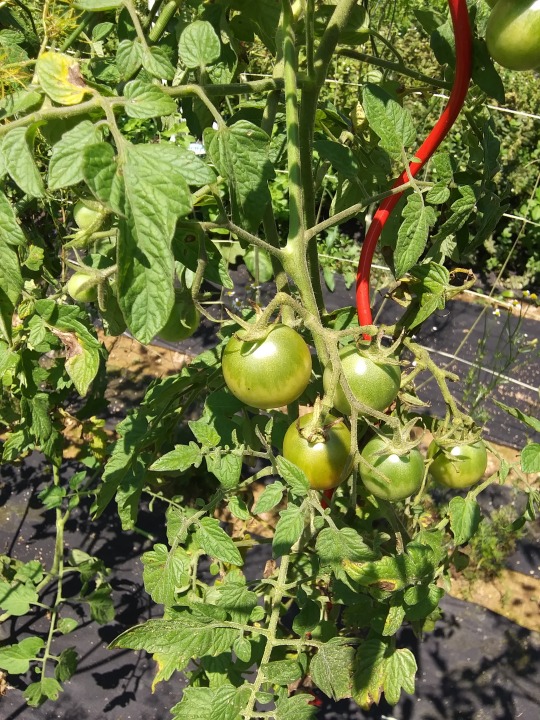
Green, white, pink and brown cherry tomatoes. Delicious!
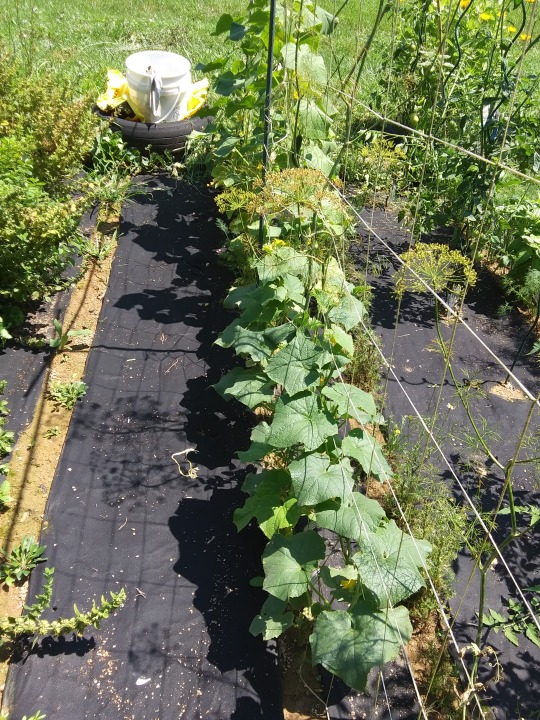
Two kinds of cucumbers, some of the only decent shots of the dill seed-heads, and a special guest hiding in the shade. I usually plant dill as soon as the cucumber sprouts, to keep cucumber beetles off it. Otherwise I’d have no cucumbers and a lot of fat beetles.

The Muncher is a small cucumber, somewhat delicate. It’s very sensitive to temperature changes, and it’s candy to cucumber beetles - basically, it’s impossible to grow it without a heavy curtain of dill, or a heavy duty decoy. This year I got lucky enough to have both. It’s also delicious pickled, keeping its crunch and getting a good ooomph in flavor.
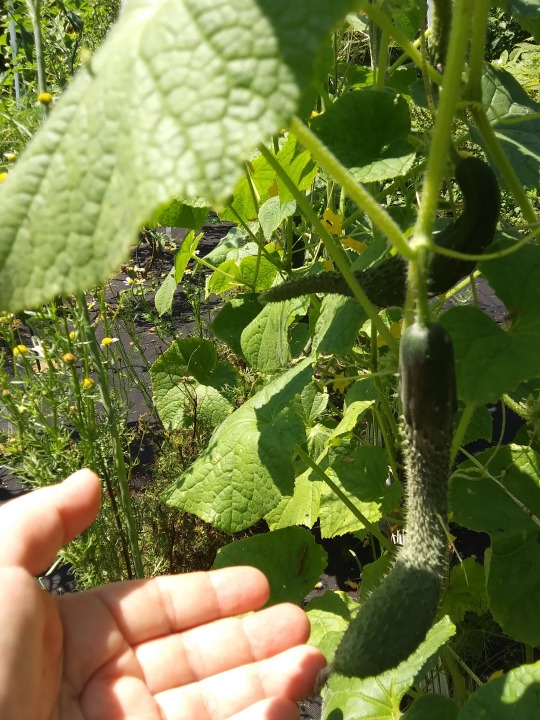
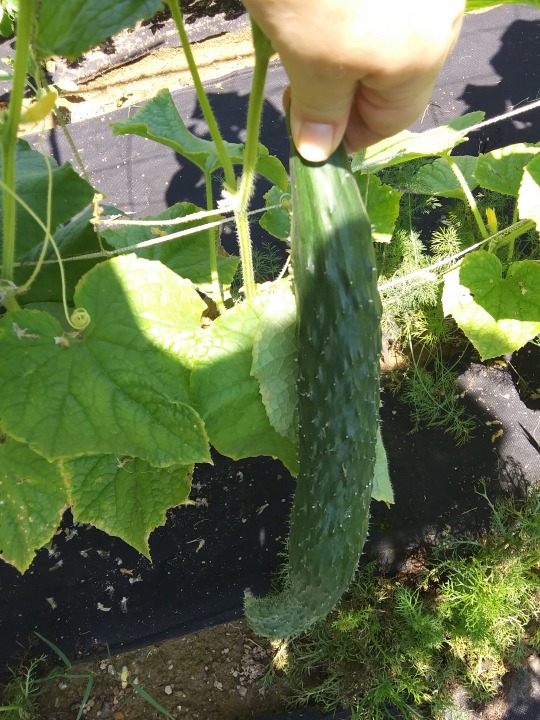
The Japanese Long is, as the name implies, long. It’s also incredibly bitey, and absolutely scrumptious. It’s sweet! And unlike the average cucumber, it does not go metallic when salted.
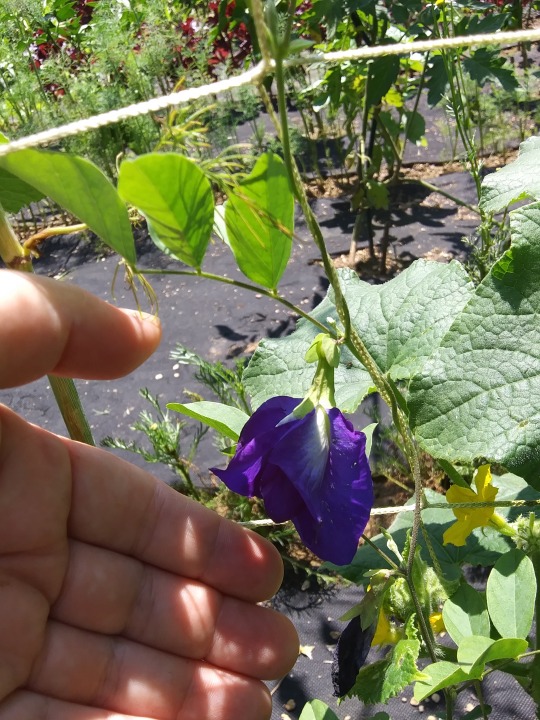
And now for the SPECIAL CHILD OF MY HEART.
Seriously. I have been lusting after Blue Tea Peas since I first saw them offered, and every single time they’d be sold out pretty much the day of. This year I finally got some and... remember me mentioning that freak freeze that killed the peach blossoms? Yeah. Guess what it also killed.
But two plants soldiered on. I have them heavily shielded by the cucumbers, dill and chamomile, and really I have no words for the blue. Pics don’t do it justice. I won’t have the tea this year, I’m saving as much seed as I can, but I am so pleased to have it at all!
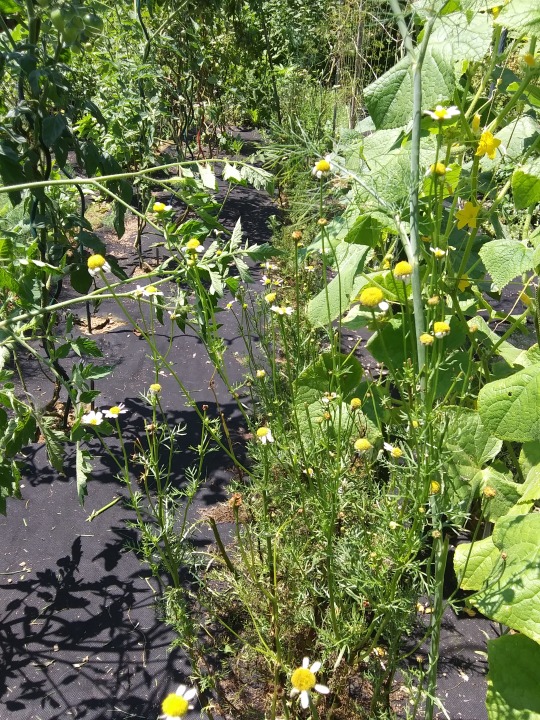
Last, but not least, and it’s a poor shot of it, the chamomile. I cannot drink chamomile to sleep - it does put me to sleep, but it also gives me bad dreams. I plan on using it as a skin wash for all the bug bites, along with the calendula, and to give me some respite from dry skin during winter.

Stay green! See you in fall! Now back to our normal schedule of frogs, cats and nekked men!
#garden#summer garden#gourd#tomatoes#calendula#hot peppers#sweet peppers#basil#dill#lettuce#red lettuce#chard#cilantro#horseradish#cucumber#amaranth#lemon balm#chamomile#blue tea pea#castor oil#zinnia#mountain phlox#echinacea#balsam#pennyroyal#thyme#oregano#lemongrass
25 notes
·
View notes
Text
If you were to write a letter to yourself, what would you say?
Dear S,
They say that when you reach the early 20s, especially at the age 25, it’s one of the most crucial stage of your life. How? Well, that’s the funny thing. Nobody knows how it’s in that stage. It just is. Some people at this age have their life sorted out while others are still taking baby steps into new beginnings. What people forget or don’t really focus on, is that everyday is a new beginning, we just don’t realize it.
I was asked a question today, if you could describe yourself in 3 words, what would it be? Nobody has ever asked that question throughout the past 25 years and while doing some hard thinking, the 2/3 words that pop up in my mind was...sad and tiring. Looking back, I only said the negative things in my head but instead, I owe it to you to say about the things that you went through and my apologies for letting you go through it. So I hope, you’d bear with me when I write these words down.
I’m proud of you.
You went through a lot didn’t you? I know that you did your very best to hold it together even though you always said you didn’t know how you did it but you did. I know that you still blame yourself for your parents divorce. Their fights, their arguments. I know that deep down you wish you could’ve save mom from all of it, or somewhat protected her from those dark moments.
It was heartbreaking to see you cry on the balcony screaming your lungs out when you found out what had happened to mom that day. The betrayal she had to face from the people she thought were her friends. It was more tragic to see you going back home hugging your siblings tightly since that night, you only had each other. Only the 3 of you. Praying that mom would be alright wherever she was sent to those nights. I’m sorry I couldn’t hug you. I’m sorry that I had to watch you break down on your knees asking where mom was. I’m sorry that you had to blame yourself for not seeing the signs sooner. I’m sorry I couldn’t warn you what was going to happen.
You might not see it yet, and you actually don’t see it now but you’re a good sister. You might think you’re not the best, but you are what your siblings need right now and that is more than enough. I’m proud that you were able to hug your sister when she cried on your lap asking where mom was. I’m glad you were able to put your baby brother to sleep, even though he asked why mom wasn’t there for his birthday. You were there for them during that time of need, and you were such a good sister. Mom was really proud of you the moment she came back home, I hope you know that.
I’m sorry for mistreating you by hurting your wrist with the keys that were right on the table. I’m sorry for not being able to remind you of your worth during that time, for not wiping your tears when you felt like everyone betrayed you. I’m sorry you had to beg to not go anywhere, to just stay where you are, to isolate yourself in your room from everyone. It was hard for you back then but 4 years later and here you are. Still going through it.
I’m sorry I let you chase someone who doesn’t want your existence in their life anymore. I’m sorry you had to witness the person you trusted the most look someone else in the eyes the way that he used to look at you. I know how hard it was going through the pain of never being good enough for him, for his family, for his surroundings, no matter how hard you try. For not being able to live up to their social status, for not being accepted. But please know that at the end of the day, you were true to who you were at that time. You didn’t pretend to be someone else to live up to their social status, you did well.
I know how much you loved studying back then. How much doing presentations in front of the entire class was something that you admire the most doing. Given the opportunity to study back at the place where you grew up in was a dream for you, so I know how extremely hard it was for you to leave everything behind for the ones you love. You might not be able to get your degree because you wanted to put your family first, and it is not a bad thing. It’s actually a thing worth sacrificing for. You’ll get your opportunity one day, heck, you might even get a better opportunity than that. I hope you remember what I told you earlier, you’re doing your best as a sister and also as a daughter. I’m very proud of you.
You might forget this since it’s something that most people tend to forget, but as a daughter, mom and dad are very proud of you. I know how hard it was to witness the last words you heard from dad before he left the house was “I’m sorry”. No hug, no goodbye. How you had to wake up mom to make sure she was okay after seeing her cry every night. How you cried while only cooking for your mom and siblings from sausages and lettuce that were the only thing you found in the fridge. To be the main witness in court in your parents divorce. At such a young age and being the eldest child, you had to go through that, you’re such a strong person.
Fast forward to 2021 and here you are, able to provide a place to live for them. To be able to give them the food they crave for every now and then. Remember how you cried silently, facing your back towards your family while all four of you was sleeping on the floor with a few pillows and some blankets because you guys couldn’t afford to buy a bed at that time? Well now, you’re able to provide them the rest they need after a long tiring day. Making sure mom doesn’t work too hard and your siblings get the stuff they need to study. You’re a good person, if you don’t believe it then the least you can do is to remind yourself that you’ve made it this far for your loved ones.
Lastly, I want to say sorry for what happened last year. Letting someone in your life wasn’t an easy thing to do after what you’ve been through. Having to pour every ounce of affection, passion, everything in you to one person to show how much you were ready to start it all over again, only to be left alone, crying in a bed in the middle in the city trying to figure out what signs didn’t you see. The feeling of being used, of finally realizing that you were just a rebound, to be played as if you were just an object. I wish, I was able to hug you that night but all I could do was to just watch. I’m sorry that you had to ask him where you stand in his life. I’m sorry for not reminding you of your self worth at that time. I’m sorry. I’m so sorry, since the most vulnerable part in yourself is the love you have for people. I’m so sorry for last year.
25 years we’ve been with each other, but I am still learning more about you and starting from today, I’m going to learn on how to accept. To accept the flaws in you. To be there for you despite what happens. To celebrate every celebration, big or small. They say that in order to love others, you have to learn how to love yourself first. And that’s where we start okay? We’ll start from the beginning. You’re going to get through it, I don’t know how yet, but we’ll get there somehow. Here’s to 25 years, and to many more.
Love you dearly, even though we don’t know what self love is yet.
Sleep well at night and hang in there in the morning,
K.
0 notes
Text
It’s Time to Bring Back Victory Gardens
New Post has been published on http://healingawerness.com/news/its-time-to-bring-back-victory-gardens/
It’s Time to Bring Back Victory Gardens
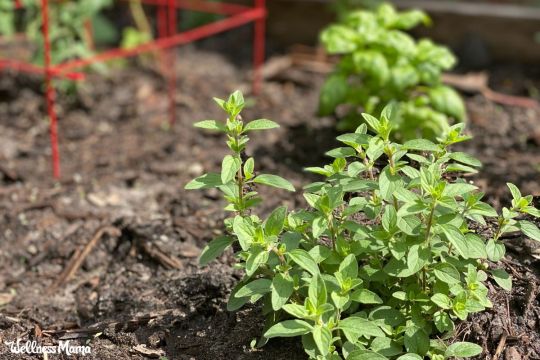

Table of Contents[Hide][Show]
During World War I and World War II, many countries encouraged their citizens to grow gardens, often called “Victory Gardens.” This relieved some of the burden on the public food supply and was marketed as a way to help the war efforts. In fact, some sources report that 41% of the food Americans consumed during these times was grown in these home gardens.
Vacant lots and public parks became fields of vegetables and many people grew beets, swiss chard, tomatoes, and lettuce in their front yards or on rooftops.
The victory garden was a practical way to improve food security on the home front. I think it’s time to bring them back in fashion!
Why Grow a Victory Garden
It’s no longer World War II, but today we face a different kind of battle. Current events remind us all too clearly that access to fresh, healthy, local food is one of the most important aspects of daily life.
Even when we are not facing a global crisis, our food system is at risk… and putting us at risk.
Of course, I’m talking about our food supply and the state of health in our country. We aren’t facing an enemy armed with rifles, but a much smaller invader that we often willingly consume and feed our children.
Most sources agree that the majority of us are not consuming enough vegetables and fruits. In fact, the CDC reported that only 27% of us are consuming the recommended amount of vegetables per day (and many experts claim that the recommended amounts are lower than they should be anyway!)
Much of our food is a source of inflammatory substances like polyunsaturated oils, sugar, and processed grains. We consume sugar to the tune of over 100 pounds per person per year and recent studies show that many of us are lacking in the basic vitamins and minerals we need for basic health.
Here’s thing: We vote with our dollars, and our actions. We can claim “victory” over over current food trends in the United States by growing our own gardens.
Bonus: Our kids are much more likely to grow up loving fresh vegetables if they eat them right off a plant that they helped to grow!
The New Battle: Rising Food Prices
We also face the problem of rising food costs. Prices are rising on all types of foods. We all know too well that organic vegetables and fruits and other “healthy” products are often especially pricey. In fact, even in the comments on this blog, the most common reason cited for not eating enough vegetables or choosing organic options is the prohibitive cost.
There are strategies for eating real food on a budget, but it’s an uphill battle. Sadly, this problem doesn’t seem likely to get better any time soon. Food prices are expected to continue to rise in the coming years and choosing to buy organic produce will only get more difficult.
It’s liberating to discover that you can grow your own organic lettuce, spinach, and kale in your own backyard (rather than buying week-old lettuce shipped in plastic from across the country!).
If starting a garden isn’t possible for you, find and support your local farmers and farmer’s markets. They can do the work for you!
Victory Gardens: A Solution to Both Problems
I’ve said before that there is much wisdom we can learn from older generations, and their knowledge of food production is no exception. Though about 40% of U.S. households grow gardens of some kind, increasing this number could address both rising food costs and increasing health issues.
Having a garden provides other benefits as well!
Statistically, gardeners live longer and there are many potential reasons for this. They spend more time outside, get more natural vitamin D, and come in contact with the rich microorganisms found in soil. Dirt has benefits of its own and the simple act of getting our hands dirty can provide immune benefits.
Many people also report stress relief and better sleep from spending time outdoors gardening.
A side benefit for families is that gardening is a great activity to do together and an excellent remedy to spending too much screen time and not enough outdoor activity.
How many things could be remedied if families would garden and walk/hike/play together?
How to Start Your Own Backyard (or Front Yard!) Garden
No matter how much (or how little) space you have, you can grow your own organic vegetables. From tiny-scale gardens like sprouts and microgreens in the kitchen to a large-scale garden in the backyard, we can all grow something!
Before we talk about methods, let me just share an important lesson I’ve learned: Don’t get bogged down by the details! Getting started is the most important step.
A Full Garden
Those who have enough room can grow much or all of their own food on their own property. Where we live, many people do this, and I’ve heard my in-laws talk about how they grew all of their own produce growing up. Even a 10 x 10 garden can grow a tremendous amount of food and is a great family activity.
Those without enough backyard space have gotten creative as well. Some people are growing beautiful front-yard vegetable gardens to make use of limited space.
New to gardening? Consider using an app (like this one) to plan and know optimal spacing and planting times for your zone. I’ll also list some of my favorite books and how-to videos for beginning gardeners at the end of this post.
Square Foot Garden
A highly efficient way of gardening that has gained popularity in recent years, square foot gardening allows those with small yards to produce a large amount of food.
Square foot gardens are typically raised beds that add soil on top of the existing ground and soil. They are more expensive up-front but are easy to maintain and typically produce very high yields. In fact, one small square foot garden can grow enough produce for an entire family if cared for correctly.
Square foot gardening turns the idea of traditional garden rows on its head and maximizes space by planting in one-foot square blocks. It’s a great way to maximize a small garden plot.
Rooftop or Container Garden
Families with limited outdoor space can grow a container garden of some kind. A small planter can grow lettuce, spinach or herbs, while a larger planter box can grow a small square foot garden. Even a tiny window box on the outside of the window can contribute some greens or herbs.
The following plants grow quite well in containers:
Sweet peas
Strawberries
Basil and herbs
Lettuce
Tomatoes
Look at the flower pots and containers you have around and get creative! Wash them out with soap and water, add some potting soil (recipe to make your own here), and follow the directions on the seed packet.
Container gardening is also great for getting an early start on the season, because you can cover or bring plants inside easily if frost threatens.
Vertical Gardening
If you don’t have a lot of space, grow up! Vertical methods of gardening can work in a traditional garden plot, in a raised bed, or in containers on a patio or balcony. Peas, beans, and even squash can grow in less space with a simple support or trellis.
Sprouts + Microgreens
Even families with absolutely no outdoor space can grow some food indoors. Lettuce, kale, spinach, or even broccoli or sunflowers are incredibly nutritious and delicious at the sprout or microgreen stage. You can be eating fresh greens in a matter of a week, all grown at home!
Foods like sprouts will grow easily in glass jars on a kitchen counter, and with a little more work, a tray of microgreens can create a lot of nutrition for a family.
This video explains how to grow your own microgreens step by step. Even kids will love to follow along and help! (And are much more likely to eat green veggies if they help grow them!)
Tips for Getting Started
Want to get started (but not overwhelmed)? Here are some practical tips I’ve learned from trial and error over the years. Hopefully they help you get off to a smooth start!
Start Small – Variety usually is the spice of life, but not so great for the new gardener. If you’re new to gardening or a self-proclaimed “black thumb,” start with just three or four types of easy to grow vegetables. I wouldn’t suggest trying to grow anything in the cabbage family your first year, for example, since they are a magnet for pests and difficult to grow organically.
Choose Easy to Grow Veggies – Herbs, swiss chard, kale, and zucchini are easy to plant, hardy, and keep producing for much of the summer.
Pick Veggies That Are Fun for Kids – Sweet peas, cherry tomatoes, strawberries, mini sweet peppers (also called lunchbox peppers), and scarlet runner beans are all crops my kids have loved. Think small, sweet, and easy to pick and snack on. Consult the Vegetable Gardening Week by Week book below or research gardening sites to know what to plant when.
Use Local Gardening Networks – Chances are many gardening groups exist in your area. Join online groups for advice, seedling swaps, and local plant sales.
Add Some Beauty – Don’t forget to add a pot of flowers to your container garden! They help attract pollinators and add some color! Nasturium and calendula are beautiful edible flowers, and zinnias make an easy to grow cut flower.
Supplies for Victory Gardens
Here are some resources if you’re just getting your feet wet:
Organic Gardening 101 – Find step by step guidance in this post.
Vegetable Gardening Week by Week – If you buy only one gardening book, this should be it. It lays out exactly what to plant when with a simple formula based on your local last frost date.
Biochar Soil Amendment – In an organic garden, it’s all about the soil. I can’t say enough about this natural fertilizer designed to restore the minerals and microbial balance so lacking in much of our soil today. I add it to potting soil or right into the garden beds. It’s a great option if you don’t have homemade compost on hand (yet).
Seeds or Seedlings – Get them from your local grocery or nursery, or order them online. Seed companies often have a wealth of knowledge in their catalogs and websites. Try seed companies with organic, non-GMO seed like Johnny’s or Seed Saver Exchange. Also check online groups in your area as many gardeners will give away seedlings for free or very cheap!
Some Flats or Pots – Most anything that holds soil but has drainage holes will work! I’ve saved pots from past flower gardens or drilled holes into containers from yogurt. I’m also a fan of peat pots because they are biodegradeable.
There are many ways to plan your garden, but experience is always the best teacher. Victory gardeners were certainly not all gardening experts!
When in doubt, apply seed to soil in a sunny spot, water, and see what happens!
I challenge you all to start your own victory gardens! Are you up to the challenge? What are you going to grow this year?
Source: https://wellnessmama.com/118967/victory-gardens/
1 note
·
View note
Text
An introduction to square-foot gardening
I grew up in the country. My family always had a vegetable garden. For us, gardening meant a large plot, plowed and raked, then planted with long, widely-space rows of vegetables. It also meant weeding and hoeing, weeding and hoeing. Lots and lots of weeding and hoeing.
Gardening was a chore.
When my ex-wife and I bought our first home, we both wanted a vegetable garden, but we didn't want the drudgery that came with it. Besides, we didn't have a big space in the country — we had an average city lot. Fortunately, we discovered Mel Bartholomew's Square-Foot Gardening.
Bartholomew's method allowed us to enjoy reasonable crop production in a small space. With his technique, almost any homeowner can grow her own food.
How Square-Foot Gardening Works
The square-foot gardening concept is simple: Build a raised bed. Divide the space into sections of one square-foot each. Lastly, plant vegetables (and/or flowers) in just the amount of space they need.
The advantages of this system include reduced workload, less watering, easy weeding (and not much of it), and easy access to your crops. This is a great way to learn to grow some of your own food.
Back in the 1990s, Kris and I had raised beds similar to these (from Flickr user johnyaya).
We built our square-foot garden one Saturday in mid-April. I spent the morning constructing three raised beds out of two-by-sixes. Each bed was twelve feet long, four feet wide, and twelve inches tall. At the time, I most certainly was not a handyman, yet I was able to build these in just a few hours. It was fun.
Digging was less fun.
I spent the afternoon double-digging three patches in our lawn. We maneuvered the frames into place, leveled them, and then filled them with rich soil (purchased from a nearby nursery-supply center). Finally, we created a grid over each bed using tacks and twine. When we were finished, our raised beds looked like orderly grids.
After we built the raised beds and outlined the growing space, we followed the guidelines in Bartholomew's book.
The ten basic tenets of square-foot gardening are:
Layout. Arrange your garden in squares, not rows. Lay it out in roughly 48 inches (125cm) x 48 inches (125cm) planting areas.
Boxes. Build boxes to hold a new soil mix above ground.
Aisles. Space boxes 36 inches (100cm) apart to form walking aisles.
Soil. Fill boxes with Bartholomew's special soil mix: 1/3 blended compost, 1/3 peat moss, and 1/3 coarse vermiculite.
Grid. Make a permanent square foot grid for the top of each box. (The book and website insist that this is a must. I think a temporary grid works fine.)
Care. Never walk on your growing soil. Tend your garden from the aisles.
Select. Plant a different flower, vegetable, or herb crop in each square foot, using one, four, nine, or sixteen plants per square foot.
Plant. Conserve seeds. Plant only a pinch (two or three seeds) per hole. Place transplants in a slight saucer-shaped depression.
Water. Water by hand from a bucket of sun-warmed water.
Harvest. When you finish harvesting a square foot, add compost and replant it with a new and different crop.
You might, for example, plant a single tomato in a square, but you'd plant sixteen carrots in another. Using this system, you can cram a lot of garden into a small space and still get excellent yields.
The official square-foot gardening website includes several handy planting chart cheat sheets to help with planning and planting.
My Square-Foot Garden
I haven't had much of a garden since Kris and I got divorced seven years ago. When Kim and I bought our country acre in 2017, it came with three ramshackle raised beds. We've made the most of these — well, Kim has, anyhow — but not in any sort of systematic way.
This year, we took down a gangly cedar tree that dominated one corner of our yard. In its place, we planted three fruit trees, four blueberry bushes, and four grape vines. Last weekend, in a mad fit of productivity, I decided to add two new raised beds.
Using scavenged lumber (we have a stack of good stuff after replacing our carport and back deck), I build two solid boxes. I filled them with the dirt I'd removed when we put in the orchard in March. (Although it's not the “official” square-foot gardening mixture, I topped the beds with bagged soil purchased from a local nursery.)
Because it's far too late for me to start most plants from seed this year, I opted to purchase starts from the same nursery.
In the smaller raised bed, I started an herb garden.
In the larger raised bed, I planted both flowers and some cool-climate veggies (such as carrots, lettuce, and peas).
As you can see, I applied the square-foot methodology but I didn't actually use a grid. (And because I don't own a copy of the book anymore, I guessed at spacing.)
Within hours, the herb garden was infested with pests. (Probably because I planted some “pestnip”.)
In retrospect, I ought not to have planted catnip next to my other herbs. Avery has destroyed both catnip plants already, and he took out the winter savory in the process. (Plus, he damaged the cilantro and the parsley.)
Further Reading
I'm very excited to have a garden again. It's been a l-o-n-g time since I've been serious about growing my own food. Plus, Kim is into it too. She's been growing seedlings this spring, and she planted them out yesterday. Once the weather warms a bit more, she'll plant some tomato and pepper and basil starts. By the end of the summer, we should have some good eating!
If you'd like to experiment with square-foot gardening, Mel Bartholomew's book is excellent. But you can also find info online at the square-foot gardening forum and this terrific tutorial from Journey to Forever.
If you don't have the time or space to construct raised beds, consider starting a container garden. Apartment-dwellers can get good results from plants grown in large self-watering pots on a patio or balcony. (Here's a review of The Bountiful Container written by my ex-wife in 2008.)
In any event, now's the time to get your garden space ready in many parts of the U.S. The danger of frost has passed for most of us. Garden fairs and plant sales have begun to pop up like weeds. Get out there and grow some food!
This is an updated version of an article originally published here on 21 April 2007. The info is the post is current, but some of the comments might be outdated.
The post An introduction to square-foot gardening appeared first on Get Rich Slowly.
from Finance https://www.getrichslowly.org/an-introduction-to-square-foot-gardening/
via http://www.rssmix.com/
0 notes
Text
An introduction to square-foot gardening
I grew up in the country. My family always had a vegetable garden. For us, gardening meant a large plot, plowed and raked, then planted with long, widely-space rows of vegetables. It also meant weeding and hoeing, weeding and hoeing. Lots and lots of weeding and hoeing.
Gardening was a chore.
When my ex-wife and I bought our first home, we both wanted a vegetable garden, but we didn't want the drudgery that came with it. Besides, we didn't have a big space in the country — we had an average city lot. Fortunately, we discovered Mel Bartholomew's Square-Foot Gardening.
Bartholomew's method allowed us to enjoy reasonable crop production in a small space. With his technique, almost any homeowner can grow her own food.
How Square-Foot Gardening Works
The square-foot gardening concept is simple: Build a raised bed. Divide the space into sections of one square-foot each. Lastly, plant vegetables (and/or flowers) in just the amount of space they need.
The advantages of this system include reduced workload, less watering, easy weeding (and not much of it), and easy access to your crops. This is a great way to learn to grow some of your own food.
Back in the 1990s, Kris and I had raised beds similar to these (from Flickr user johnyaya).
We built our square-foot garden one Saturday in mid-April. I spent the morning constructing three raised beds out of two-by-sixes. Each bed was twelve feet long, four feet wide, and twelve inches tall. At the time, I most certainly was not a handyman, yet I was able to build these in just a few hours. It was fun.
Digging was less fun.
I spent the afternoon double-digging three patches in our lawn. We maneuvered the frames into place, leveled them, and then filled them with rich soil (purchased from a nearby nursery-supply center). Finally, we created a grid over each bed using tacks and twine. When we were finished, our raised beds looked like orderly grids.
After we built the raised beds and outlined the growing space, we followed the guidelines in Bartholomew's book.
The ten basic tenets of square-foot gardening are:
Layout. Arrange your garden in squares, not rows. Lay it out in roughly 48 inches (125cm) x 48 inches (125cm) planting areas.
Boxes. Build boxes to hold a new soil mix above ground.
Aisles. Space boxes 36 inches (100cm) apart to form walking aisles.
Soil. Fill boxes with Bartholomew's special soil mix: 1/3 blended compost, 1/3 peat moss, and 1/3 coarse vermiculite.
Grid. Make a permanent square foot grid for the top of each box. (The book and website insist that this is a must. I think a temporary grid works fine.)
Care. Never walk on your growing soil. Tend your garden from the aisles.
Select. Plant a different flower, vegetable, or herb crop in each square foot, using one, four, nine, or sixteen plants per square foot.
Plant. Conserve seeds. Plant only a pinch (two or three seeds) per hole. Place transplants in a slight saucer-shaped depression.
Water. Water by hand from a bucket of sun-warmed water.
Harvest. When you finish harvesting a square foot, add compost and replant it with a new and different crop.
You might, for example, plant a single tomato in a square, but you'd plant sixteen carrots in another. Using this system, you can cram a lot of garden into a small space and still get excellent yields.
The official square-foot gardening website includes several handy planting chart cheat sheets to help with planning and planting.
My Square-Foot Garden
I haven't had much of a garden since Kris and I got divorced seven years ago. When Kim and I bought our country acre in 2017, it came with three ramshackle raised beds. We've made the most of these — well, Kim has, anyhow — but not in any sort of systematic way.
This year, we took down a gangly cedar tree that dominated one corner of our yard. In its place, we planted three fruit trees, four blueberry bushes, and four grape vines. Last weekend, in a mad fit of productivity, I decided to add two new raised beds.
Using scavenged lumber (we have a stack of good stuff after replacing our carport and back deck), I build two solid boxes. I filled them with the dirt I'd removed when we put in the orchard in March. (Although it's not the “official” square-foot gardening mixture, I topped the beds with bagged soil purchased from a local nursery.)
Because it's far too late for me to start most plants from seed this year, I opted to purchase starts from the same nursery.
In the smaller raised bed, I started an herb garden.
In the larger raised bed, I planted both flowers and some cool-climate veggies (such as carrots, lettuce, and peas).
As you can see, I applied the square-foot methodology but I didn't actually use a grid. (And because I don't own a copy of the book anymore, I guessed at spacing.)
Within hours, the herb garden was infested with pests. (Probably because I planted some “pestnip”.)
In retrospect, I ought not to have planted catnip next to my other herbs. Avery has destroyed both catnip plants already, and he took out the winter savory in the process. (Plus, he damaged the cilantro and the parsley.)
Further Reading
I'm very excited to have a garden again. It's been a l-o-n-g time since I've been serious about growing my own food. Plus, Kim is into it too. She's been growing seedlings this spring, and she planted them out yesterday. Once the weather warms a bit more, she'll plant some tomato and pepper and basil starts. By the end of the summer, we should have some good eating!
If you'd like to experiment with square-foot gardening, Mel Bartholomew's book is excellent. But you can also find info online at the square-foot gardening forum and this terrific tutorial from Journey to Forever.
If you don't have the time or space to construct raised beds, consider starting a container garden. Apartment-dwellers can get good results from plants grown in large self-watering pots on a patio or balcony. (Here's a review of The Bountiful Container written by my ex-wife in 2008.)
In any event, now's the time to get your garden space ready in many parts of the U.S. The danger of frost has passed for most of us. Garden fairs and plant sales have begun to pop up like weeds. Get out there and grow some food!
This is an updated version of an article originally published here on 21 April 2007. The info is the post is current, but some of the comments might be outdated.
The post An introduction to square-foot gardening appeared first on Get Rich Slowly.
from Finance https://www.getrichslowly.org/an-introduction-to-square-foot-gardening/
via http://www.rssmix.com/
0 notes